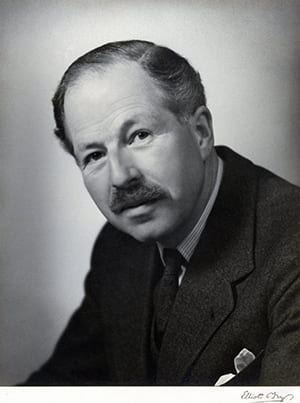
Lynton Lamb
 Artist, Book Designer and Illustrator (1907-1977)
Artist, Book Designer and Illustrator (1907-1977)
The son of a Methodist minister Lynton Harold Lamb was born on 15 April 1907 in Hyderabad, India. At the age of sixteen, following the death of his father, he started work in an estate agent’s office while attending evening classes in life drawing at Camberwell School of Art. In 1928 he was able to return full time to his artistic studies at the Central School of Arts and Crafts, where he also learnt the craft of printing, under one of the first Royal Designers for Industry (RDI) John H. Mason.
When he left in 1930 Lamb joined Oxford University Press at Amen House, London where he redesigned the bindings of their prayer books and bibles while continuing his studies for several hours a week at the Central School under another of the first RDIs, Douglas Cockerell. When Cockerell left to focus on his business Lamb took over his position and taught bookbinding design two mornings a week, until the outbreak of the Second World War when Lamb served as a staff officer, working with the Royal Engineers alongside Oliver Messel and William Coldstream on camouflage. Lamb lectured on methods and materials in the Royal Academy’s Painting School (1956-70) and on lithography at the Slade School (1950-71).
After the war he received commissions for the commemorative binding for the lectern Bible for St Giles’s Cathedral, Edinburgh (1948) and for the Bible used at the Coronation of HM Queen Elizabeth II (1953). Lamb designed the postage stamps for the new reign, for which he received the International Philatelic Art Society Award, and he served on the Design Council’s Coronation Souvenirs Committee with future RDI, Sir Gordon Russell.
With many other future RDIs Lamb produced designs for the Orient Line ships (1935-50) while his painting career developed alongside his other artistic output. For many years he shared a studio with Victor Pasmore, who had studied with him at the Central School, and who included Lamb in his painting The Parisian Café. A year after the publication of his first book The Purpose of Painting (1936) Lamb held his first exhibition at the Storran Gallery, London. His last was at the Radlett Gallery in the year before he died. As well as books on painting, illustration and cats, Lamb was also the author of the Inspector Charles Glover detective stories and a topographic book, County Town. Backs and Fronts in Kennelsford, (1950). He illustrated over fifty books, including the first edition of Flora Thompson’s novel, Lark Rise (1939) and the Oxford Illustrated Trollope, his work appeared in the Radio Times, and he wrote articles for Graphis, Studio, Signature and the Penrose Annual.
As well as Britain Can Make It (1946) Lamb’s work also featured in British Art in Industry (1935) and the Arts & Crafts Exhibition Society 50th Anniversary Exhibition (1938). He was one of the artists invited by the Arts Council to contribute a large painting for the Festival of Britain travelling exhibition ‘Sixty Paintings for 1951’.
Lamb was President of the Society of Industrial Artists (1951-53); member of the Fine Arts Panel of the Arts Council (1951-54); the Design Council (1952-55); National Advisory Committee on Art Examinations (1953-55); Graphic Panel of the National Council for Diplomas in Art & Design, and an examiner on the external boards for the University of Reading and Liverpool College of Art. A Fellow of the Royal Society of Arts (FRSA) from 1953 Lamb was awarded their silver medal for his paper on ‘The Art of Book Illustration’ in 1962. On receiving the distinction of Royal Designer for Industry (RDI) in 1974 Lamb wrote ‘I am happy to accept this from my peers as an apt and just acknowledgement that “I have done the state some service and they know’t”.
Lamb died at Sandon, Essex on 4 September 1977.
Britain Can Make It Exhibition Catalogue 1946
- Group RR: Furnished Rooms – item 473
Further reading
George Mackie, Lynton Lamb Illustrator (London:Scolar, 1978)
Photo courtesy of the RSA. Photograph by Elliott and Fry Ltd., Baker Street, No. F16657B.
